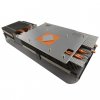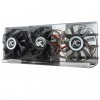I would be very much in favour of a full spectrum setup as opposed to dual....
However as a novice and just starting to get to grips with the theory It is easier to "half get it right" when coming up with a specific flower or veg spectrum.
I fear with a Full spectrum It would be alot more sensitive to good design and theory behind it so that it performs adequately for both cycles of veg and flower and alot more punishing for small errors in the wavelenghts used...
I will rethink my veg spectrum and reduce the CW a good bit and ww a tiny bit in favour of a bit of red............
REVISED Veg Spectrum:
42% Warm White xt-e - 8% Red 630 - 12.5 % Red 660- 37.5% Cold White xt-e ( In my vegging mode led no. = 20WW : 6(660) : 4(630): 18CW )
However as a novice and just starting to get to grips with the theory It is easier to "half get it right" when coming up with a specific flower or veg spectrum.
I fear with a Full spectrum It would be alot more sensitive to good design and theory behind it so that it performs adequately for both cycles of veg and flower and alot more punishing for small errors in the wavelenghts used...
I will rethink my veg spectrum and reduce the CW a good bit and ww a tiny bit in favour of a bit of red............
REVISED Veg Spectrum:
42% Warm White xt-e - 8% Red 630 - 12.5 % Red 660- 37.5% Cold White xt-e ( In my vegging mode led no. = 20WW : 6(660) : 4(630): 18CW )







